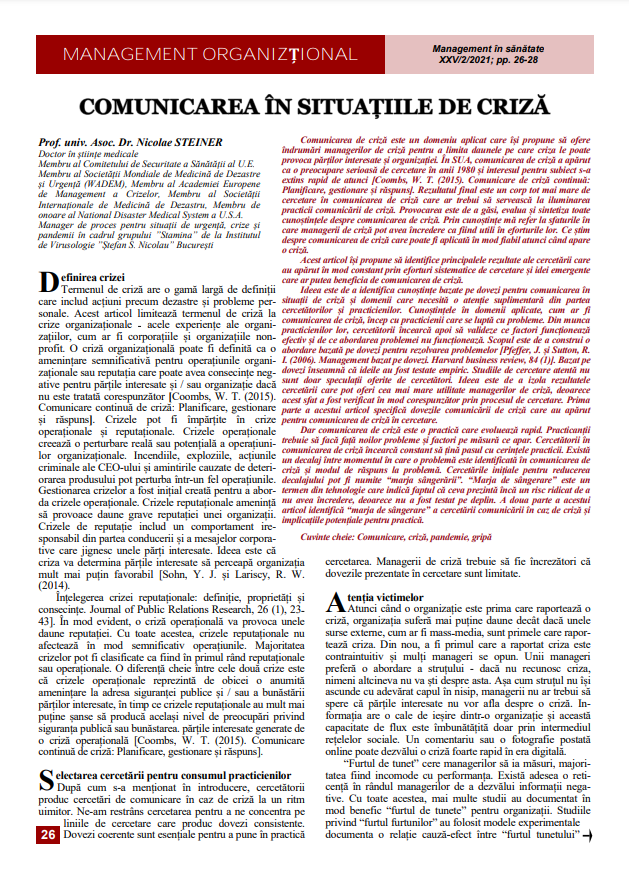Rezumat
Comunicarea de criză este un domeniu aplicat care își propune să ofere îndrumări managerilor de criză pentru a limita daunele pe care criza le poate provoca părților interesate și organizației. În SUA, comunicarea de criză a apărut ca o preocupare serioasă de cercetare în anii 1980 și interesul pentru subiect s-a extins rapid de atunci [Coombs, W. T. (2015). Comunicare de criză continuă: Planificare, gestionare și răspuns]. Rezultatul final este un corp tot mai mare de cercetare în comunicarea de criză care ar trebui să servească la iluminarea practicii comunicării de criză. Provocarea este de a găsi, evalua și sintetiza toate cunoștințele despre comunicarea de criză. Prin cunoștințe mă refer la sfaturile în care managerii de criză pot avea încredere ca fiind utili în eforturile lor. Ce știm despre comunicarea de criză care poate fi aplicată în mod fiabil atunci când apare o criză.
Acest articol își propune să identifice principalele rezultate ale cercetării care au apărut în mod constant prin eforturi sistematice de cercetare și idei emergente care ar putea beneficia de comunicarea de criză.
Ideea este de a identifica cunoștințe bazate pe dovezi pentru comunicarea în situații de criză și domenii care necesită o atenție suplimentară din partea cercetătorilor și practicienilor. Cunoștințele în domenii aplicate, cum ar fi comunicarea de criză, încep cu practicienii care se luptă cu probleme. Din munca practicienilor lor, cercetătorii încearcă apoi să valideze ce factori funcționează efectiv și de ce abordarea problemei nu funcționează. Scopul este de a construi o abordare bazată pe dovezi pentru rezolvarea problemelor [Pfeffer, J. și Sutton, R. I. (2006). Management bazat pe dovezi. Harvard business review, 84 (1)]. Bazat pe dovezi înseamnă că ideile au fost testate empiric. Studiile de cercetare atentă nu sunt doar speculații oferite de cercetători. Ideea este de a izola rezultatele cercetării care pot oferi cea mai mare utilitate managerilor de criză, deoarece acest sfat a fost verificat în mod corespunzător prin procesul de cercetare. Prima parte a acestui articol specifică dovezile comunicării de criză care au apărut pentru comunicarea de criză în cercetare.
Dar comunicarea de criză este o practică care evoluează rapid. Practicanții trebuie să facă față noilor probleme și factori pe măsură ce apar. Cercetătorii în comunicarea de criză încearcă constant să țină pasul cu cerințele practicii. Există un decalaj între momentul în care o problemă este identificată în comunicarea de criză și modul de răspuns la problemă. Cercetările inițiale pentru reducerea decalajului pot fi numite “marja sângerării”. “Marja de sângerare” este un termen din tehnologie care indică faptul că ceva prezintă încă un risc ridicat de a nu avea încredere, deoarece nu a fost testat pe deplin. A doua parte a acestui articol identifică “marja de sângerare” a cercetării comunicării în caz de criză și implicațiile potențiale pentru practică.

